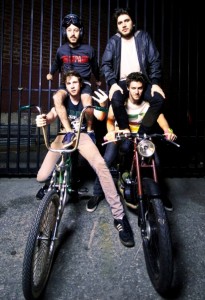Tohoku Earthquake benefit: Rock Chicks’ Revenge (Tokyo – June 4)
JET alum Sarah Cortina is one of the co-organizers of the Rock Chicks’ Revenge (Rock Gods Must Die) which will happen June 4 in Tokyo’s Shibuya Milkyway from 6pm-10pm with a special guest appearance by the Blue Man Group.
See full details at Metropolis Magazine.
Justin’s Japan: New York’s Japan Society Ready to Rock with Hikashu, Tomoe Shinohara
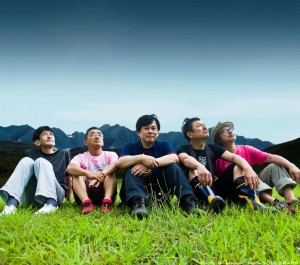
- Hikashu headlines New York’s Japan Society May 13 with Tomoe Shinohara and Steve Eto. (Ikeda Masaaki & Makigami Koichi)
By JQ magazine editor Justin Tedaldi (CIR Kobe-shi, 2001-02) for Examiner.com. Visit his page here to subscribe for free alerts on newly published stories.
This Friday (May 13), Japan Society’s Performing Arts Season goes into overdrive with Hikashu and Tomoe Shinohara Live in Concert, a special one-night-only event featuring the North American debut of legendary band Hikashu with special guests Tomoe Shinohara and Steve Eto.
Drawing on more than thirty years in the music business, Hikashu combines J-pop, new wave and electronic pop, taking listeners on unparalleled musical journeys through its signature sound. Led by its founder, enigmatic vocalist Makigami Koichi (vocal, theremin, cornet), the group’s members include Mita Freeman (guitar, sampler), Sakaide Masami (bass, electronics), Shimizu Kazuto (piano, synthesizer, bass-clarinet) and Sato Masaharu (drums, voice). Currently a lecturer at Shizuoka University of Art and Culture, Koichi has performed at Japan Society twice before as part of the New Voices from Japan series curated by John Zorn (2006) and Ikue Mori: Celebrating 30 Years of Live, Love & Music in NYC also curated by Zorn (2008).
Joining headliners Hikashu at the Manhattan venue is singer, actress and Japanese pop culture icon Tomoe Shinohara with percussionist Steve Eto. Best known to anime fans in the West for singing “Ultra Relax,” the title song of Kodomo no Omocha (released as Kodocha in North America), Shinohara is a choice stylistic counterpoint to the sounds on display. As a musician, songwriter and lyricist, Shinohara (or Shinorer, as her Japanese fans affectionately call her) has released a score of albums, featuring guest spots from artists as diverse as Pizzicato Five, Cibo Matto and Julio Iglesias(!).
For the rest of the story, click here.
JETAA Florida to provide volunteers for South Florida events this weekend
Thanks to JETAA Florida President Bahia Simons-Lane (Gunma-ken) for sharing the following:
JETAA Florida is providing volunteers for two events in South Florida this weekend:
1. Japan Culture Day at Florida International University
2. Miami Reggae Festival for Japan Relief in Coconut Grove
See Bahia’s blog for full details.
Japan Society Presents Hikashu & Tomoe Shinohara in Concert
The Japan Society will be hosting an upcoming concert featuring J-techno pop band Hikashu & Tomoe Shinohara on May 13. 50% of all ticket sales from this event will go to Japan Society’s Earthquake Relief Fund.
Click Here to find out more information about the show.
Posted by Sam Frank, an ALT who taught English in Hiraizumi-Cho, Iwate Prefecture from 2002-2004 and worked in Shirahama-cho, Wakayama Prefecture as a JET from 2004-2006. He currently manages the New York Division of UnRated Magazine and works as a Project Manager/Web Producer at Arrow Root Media.
Justin’s Japan: Deep Purple Guitarist Steve Morse Weighs in on the Japan Catastrophe
By JQ magazine editor Justin Tedaldi (CIR Kobe-shi, 2001-02) for Examiner.com. Visit his page here to subscribe for free alerts on newly published stories.
Throughout its career, Deep Purple–who formed in England in 1968 and released their debut album that year–has sold over 100 million albums worldwide. Revered in Japan, their iconic rock hits include “Smoke on the Water,” “Highway Star,” and “Woman from Tokyo.” After a four-year hiatus from American shores, the band’s upcoming tour, called Deep Purple: The Songs That Built Rock, finds them returning with a symphony orchestra.
In this exclusive interview, I spoke with Steve Morse, the group’s guitarist since 1994, about the tour, and his thoughts on the cataclysmic events happening in Japan.
Regarding the recent catastrophe in Japan, is the band planning to do any special shows or benefits at this point?
No, we haven’t gotten anything that we’re privy to at the moment. I think the thing in Japan is, they sort of differ from a Third World country that just totally doesn’t know what to do. The people of Japan are so incredibly organized and capable, I don’t know how anybody can help them that isn’t right there. They need all kinds of support. The logistics of getting what they need to them is obviously the problem—it’s not being able to afford it, as far as what I’ve seen. And don’t forget that at this time I’ve got a limited view, because I’m working all the time [Morse was touring with the band in Eastern Europe during this interview], and I can’t just turn on the TV and get anything set to a certain very narrow international news station.
So from my point of view, it looks like they need more logistical support than moral support to raise more money for food or anything. I could be wrong, but it looks like they’ve got that part covered, and the government is willing to do whatever it takes to get the people back on their feet and working again. But they’re handling some really amazing problems right now, and one last thing that I get from that is how incredibly dignified they are in such a time of stress.
Of course Deep Purple has a long relationship with Japan and its people, making live albums recorded there something special long before bands like Cheap Trick came along. What’s it like when you go over there as a member of the group?
Deep Purple has very old acquaintances, like promoter Mr. Udo, and everybody knows people there, so it’s a friendly, familiar place. And like I said, it’s so organized and dignified, it’s just wonderful. It’s wonderful to see a guy driving a cab that’s spotless, with white gloves on, and that’s any cab you get into.
The trains, they come exactly on time, they leave exactly on time, and they go really fast. So a lot of times we just ride the trains, because it’s the best way to go. And when you’ve got mass transit that’s that organized, even in an earthquake zone, it’s still the way to go. It beats traffic, you know? And whenever we get mass transit that’s that organized and that cool and that fast and that reliable, I think then America could really cut down on one person per Suburban, you know? (Laughs.)
Is there any place that you haven’t played yet that you’re looking forward to?
Oh, yeah. I’d like to see—and this is not a joke—Antarctica. Because I’m fascinated with technology and how people cope with things. Since I’m a member of Deep Purple, and have played outside in the snow on top of a mountain, in a desert (laughs) and in a monsoon in Korea, I think, outside, getting drenched, it seems like if we can play anywhere, we might as well go to the most extreme gig possible, and that would be Antarctica. Maybe even the North Pole, I don’t know. But there’s some parts of Africa that we haven’t been to, and that would be interesting, especially if they were able to accommodate all the power and logistics for the band. The adventure never stops.
Read the rest of the interview here.
Justin’s Japan: New York’s Blue Note Benefit for Japan concerts to stage two-night support stand
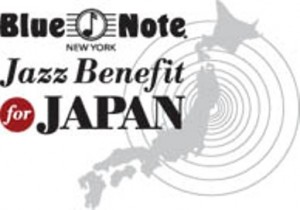
- The Blue Note Jazz Benefit for Japan concerts will be held at New York’s Highline Ballroom April 18-19. (Blue Note New York)
By JQ magazine’s Justin Tedaldi (CIR Kobe-shi, 2001-02) for Examiner.com. Visit his page here to subscribe for free alerts on newly published stories.
Japan has always been there for jazz. Now, jazz is giving back.
The Blue Note New York will host a harmonious benefit at Manhattan’s Highline Ballroom for two consecutive nights beginning Monday (April 18), with all of the ticket proceeds to be donated to the Japan Relief and Recovery Fund spearheaded by Direct Relief.
The event is being organized by talent buyer Seiko Kinoshita, who has worked at Blue Note New York since 1996. “As the details of the disaster unfolded, I felt sad and frustrated that I couldn’t do much to help, being so far away from my home country,” said the Fukuoka native. “Having worked in the jazz industry for most of my adult life, I decided to organize a benefit concert and was very encouraged by the willingness of the artists, as well as their agents and managers, to support the event. I believe that every little bit helps, and I want the Japanese people to know that New Yorkers and the jazz community care deeply about them and their country and want to do what they can to help.”
For the last 23 years, Blue Note has maintained clubs in multiple Japanese cities, with current establishments in Tokyo and Nagoya. Ron Carter, the distinguished jazz bassist who will be among the all-star musicians at Highline on April 19, wrote of his concerns and appreciation for the Japanese people: “We share the grief of the enormous loss of life and displacement of the Japanese people. I will pray for Japan’s fast recovery and will do everything in my power to help. The Japanese jazz fan is the most important supporter of my music, and I am always grateful for the years Japan has stood by my side.”
Click here for the complete story.
Anthony Bianchi back in Brooklyn for “Xaverian High School Japan Benefit Concert” tonight
Just heard from JET alum, Brooklyn native and current Inuyama City Councilman Anthony Bianchi (Aichi-ken, Inuyama-shi) that he’s back in New York for a very short stay in order to attend his alma mater Xaverian High School‘s “Japan Benefit Concert” tonight (Thursday, March 31).
Anthony notes that any JET alums around are welcome to come. [Ed. Note: Sorry for the short notice. I wasn’t able to post this until 4:21 pm and it starts at 7:00 pm.]
Start time: 7:00 pm
Location: Xaverian High School, 71st St & Shore Road in Brooklyn
Cost: $10
JET alum Lee-Sean Huang (ALT Oita-ken ’03-’06 / webmaster, JETAANY.org & JetWit) was recently spotted in a flash mob music video for the dance pop girl group Xelle. You can spot Lee-Sean in the back of the train, dancing with the big spotlights.
Justin’s Japan: Q&A with Billy Sheehan of Mr. Big
By JQ magazine’s Justin Tedaldi (CIR Kobe-shi, 2001-02) for Examiner.com. Visit his page here to subscribe for free alerts on newly published stories.
Considered by many to be the Eddie Van Halen of bass, Billy Sheehan launched his recording career in the late ’70s with the Buffalo-based rock trio Talas, then joined original Van Halen frontman David Lee Roth’s band in the mid-’80s for two platinum-selling albums. After parting with Diamond Dave, Sheehan formed Mr. Big in 1988. Best known for its hit ballad “To Be with You”—which went to number one in 15 countries including the U.S. in 1992—Mr. Big called it quits a decade later, but in 2009 the original lineup reformed for a massive tour of Asia and Europe.
In February, the band released What If…, the first album in 15 years from the reunited rockers, which instantly went gold in Japan upon release. I spoke with Billy about the new album, his long relationship with Japan, and Mr. Big’s future touring plans.
What are some of your favorite “culture shock” memories from Japan?
Let’s see. Well, I toured with a Japanese band called B’z [in 2002], and they’re a huge band. One of their singles released that I played on [1999’s “Giri Giri Chop,” with Pat Torpey] sold, I think, three or four million units in a day; they’ve sold more records in Japan than Madonna has sold. Amazing statistics; wonderful bunch of guys, too. But we’ve played in little, tiny places where very few Western bands have ever performed. We did a thing on this little island where at the hotel there weren’t even Western numbers on the doors, so I had to remember the character of the kanji on the door to try to remember which door was mine, and that was an interesting moment for me.
It must have been a thrilling experience to go on tour with them.
We played all over. In Mr. Big, that’s one thing we’ve done, as well. Most bands [play] Tokyo, Osaka, Nagoya, and that’s it. But we’ve done Sendai, Kagoshima, Niigata, Sapporo, Fukuoka; all kinds of little places, a lot of places where many bands don’t get to. In Sendai, the first time we played there, we found out that they were having a petition to have Mr. Big play there. It had 30,000 signatures on it, and the place we were playing could only hold about 5,000 people, so we asked, what happened to the other 25,000 people that signed the thing? It was pretty fun; a sweet, sweet beautiful little city, great spot. We were very lucky to see a side of Japan that not a lot of Westerners see. It’s a very inspirational experience.
In your opinion, how do you think Japan has changed from the time you first went there up until now?
I know the economy’s been in trouble for a while, so now we’re starting to see things like discount stores and prices that aren’t set anymore; that’s a new thing for them, to go into a store and not pay absolute full retail for something, which they did for a long, long time. Now, they’re actually looking for bargains. That’s an interesting cultural change that not a lot of Japanese folks are used to. Also, the idea that once you work for a company, you are there for a lifetime of work; it’s not as secure anymore. So, I do believe there is a little bit of concern and worry amongst the average folks now that things are changing, and it’s sad to see. It’ll be interesting to see how things play out in the end.
When you played the Mr. Big reunion shows in Japan in 2009, did you notice any shift in the people who were coming to the shows?
We were very, very surprised at how many young kids were in the audience. We had a few gray heads of hair out there, too, of course, but there was amazingly a very large amount of very young kids, because I guess like any band, when you’re fortunate enough to get to some plateau of success, things start to kind of become timeless, as with this whole Beatles fans thing—I’m not comparing ourselves to them, of course, but same principle. So, we’re pleasantly surprised to see a lot of very young people whose parents probably turned them on to it, or their older brothers or sisters. So, that was a great thing.
You’re spanning generations now over there.
Yeah, I think there’s probably three generations easily being represented in the audience. We’re so thankful.
You’ve been known to get extra work and gigs in Japan over the years, like the B’z tour, Hard Rock Cafe radio spots, bass clinics, and other appearances. Do these usually come to you by reputation, or do you have to actively campaign for them?
Generally, they come to me, which I’m humbled by. It’s awful nice of them to consider me for their endorsement things and what have you. Fortunately, the press in Japan is thorough and omnipresent, so we really get a lot of coverage, and if we get fortunate enough to have a reputation that precedes us, that’s pretty cool. And it’s been an incredibly lucrative thing, to be frank—we’ve made a lot of money from Japan. And when we played there, we realized that. So, we played, and I came off the stage and practically collapsed from exhaustion a couple of times, because we push hard in our appreciation for what we have now as a result of the fans there. We don’t forget it for a minute. That’s pretty awesome.
Click here for the complete interview.
Justin’s Japan: Tak Matsumoto of B’z wins first Grammy
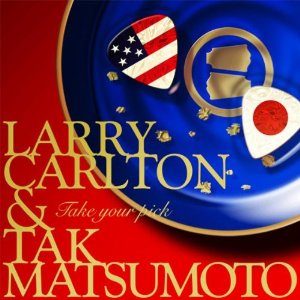
'Take Your Pick' was named Best Pop Instrumental Album last night at the 2011 Grammys. (335 Records/Vermillion Records)
By JQ magazine’s Justin Tedaldi (CIR Kobe-shi, 2001-02) for Examiner.com. Visit his NY Japanese Culture page here to subscribe for free alerts on newly published stories.
While Justin Bieber came up empty, Takahiro Matsumoto of the J-rock band B’z won big at the 53rd annual Grammy Awards in Los Angeles last night (Feb. 13).
The famed 49-year-old guitarist, commonly known Tak Matsumoto, netted his very first Grammy gold (Best Pop Instrumental Album) for Take Your Pick, a collaboration with the equally legendary American guitarist Larry Carlton.
Carlton, whose licks Matsumoto admitted to copying as a teenager, has been recording since the 1960s and has played on over 100 gold and platinum records, including discs by Steely Dan, Michael Jackson and Billy Joel. Take Your Pick, which contains original compositions by the duo supported by American session players, was released last June and goosed by a two-month Japanese tour by the axe slingers.
“I had never told anyone until now, but the Grammys was one of my dreams and a big goal,” Matsumoto said yesterday after winning the award. This was Carlton’s fourth win and 19th nomination overall.
Click here for the rest of the story.
WIT Life #154: Congratulations to Japanese Grammy Winners!
WITLife is a periodic series written by professional Writer/Interpreter/Translator Stacy Smith (Kumamoto-ken CIR, 2000-03). She starts her day by watching Fujisankei’s newscast in Japanese, and here she shares some of the interesting tidbits and trends together with her own observations.
A bit of bright news in light of the Japanese government’s confirmation that its country’s economy has indeed dropped to #2 in the world. Omedetou to the following Grammy winners!
Pop Instrumental Album
“Take Your Pick,” Larry Carlton and Tak Matsumoto (guitarist in the popular Japanese rock duo B’z, pictured here on right)
Opera Recording
“Saariaho: L’Amour De Loin,” (Japanese American) Kent Nagano, conductor; Deutsches Symphonie-Orchester Berlin and Rundfunkchor Berlin
Instrumental Soloist(s) Performance (with Orchestra)
Mitsuko Uchida (“Mozart: Piano Concertos Nos. 23 & 24,” Cleveland Orchestra)
Other winners include Japanese classical pianist Mitsuko Uchida who received Best Instrumental Soloist Performance with Orchestra, while the Best Contemporary Jazz Album award went to the Stanley Clarke Band, which includes Japanese jazz pianist Hiromi Uehara.
 Info courtesy of Diana Lee, President of AsianInNY.com. Diana is handling performances for the 32nd Asian/Pacific American Heritage Festival in New York.
Info courtesy of Diana Lee, President of AsianInNY.com. Diana is handling performances for the 32nd Asian/Pacific American Heritage Festival in New York.
The Asian/Pacific American Heritage Festival is a free, day-long celebration of Asian/Pacific Americans. On May 8th, 2011, from noon-6pm, performing groups from the New York tri-state area will take the stage in front of an audience of over 8,000 in Union Square, Manhattan.
We are currently seeking submissions for:
- Performances from artists and companies working in music and/or dance including folk, traditional, and contemporary expressions.
- Must be appropriate for a family oriented 20-30 minutes performance on an outdoor stage.
The event has a history of high media coverage featured in the New York Times, Newsday, the Village Voice, Time Out magazine, NY1 News, and many ethnic papers.
We will have a merchandizing table for performers who participate in this festival to sell their items or place their promotional materials (flyers/posters).
To submit registration or auditions for performances, please visit our registration site at: http://bit.ly/etkYAP
Deadlines:
Performances Submissions: Friday, February 18, 2011
For more information regarding the festival: www.capaonline.org
If you have any questions, please don’t hesitate to contact me here or at info [at] ASIANinNY.com.
Thank you,
Diana Lee
VP of Performance of APA Heritage Festival
Justin’s Japan: Interview with Ary Warnaar of Anamanaguchi
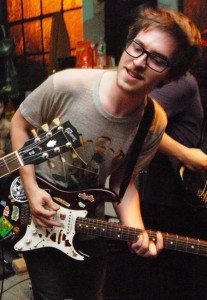
- See Ary Warnarr with Anamanaguchi at New York’s Silent Barn Saturday, Feb. 5. (Leia Jospe/leiajospe.carbonmade.com)
By JQ magazine’s Justin Tedaldi (CIR Kobe-shi, 2001-02) for Examiner.com. Visit his NY Japanese Culture page here to subscribe for free alerts on newly published stories.
The music of Anamanaguchi is part hacked Nintendo Entertainment System, part crowd surfing rave. The Brooklyn-based foursome and chiptune vanguards are on an artistic roll after releasing an acclaimed video game soundtrack based on the film Scott Pilgrim vs. the World, and earlier this month the band played packed houses at both The Studio at Webster Hall as a headliner and Irving Plaza with Super Mash Bros.
If you missed them, fear not: Anamanaguchi returns this Saturday at Silent Barn. I caught up with their co-guitarist and songwriter Ary Warnaar for this exclusive interview.
How did Anamanaguchi form, and what made you decide to specialize in playing chiptune music?
Pete [Berkman, the band’s lead songwriter] started writing chip music in 2003 and was releasing it online under the name Anamanaguchi. Once there was a demand for the music in a live setting, Pete decided to form a band. Over the years the lineup changed quite a bit, but solidified in 2007-08 with Pete on guitar, James [DeVito] on bass, Luke [Silas] on drums and me on guitar as well. I started messing around with chip music when I met Pete and James at New York University in the music technology program. I had been writing electronic music for most of my teen years and had become quite bored with most software by the time I entered college. Modern music software gives you unlimited options in terms of creation, and often lets you skip most steps of creation with presets and loops…software for limited sound chips (such as the 2A03 in the Nintendo Entertainment System) does the exact opposite. You’re extremely limited and are forced to make every note and every sound count. I found that the primitive software and extreme limitations actually made me write more complex music, and helped me focus on expressing myself. The harsh sound palette of simple squarewaves and white noise was also a breath of fresh air to me…overproduced lush sounding electronic music drenched in reverb and pads with hundreds of channels can get kinda boring. Chiptune music is a nice way of going back to basics.
What does the band’s name mean?
Before studying music technology, we were all fashion majors at the Parsons School of Design. Pete and James both interned for Armani, I was a secretary at Prada, and Luke worked at the Gucci store in SoHo. Whenever we showed up at fashion parties, people would always call us as the “Armani-Prada-Gucci” boys. After a couple bottles of Veuve Clicquot, people just started slurring the nickname into “Anamanaguchi.” We quickly realized the fashion world wasn’t for us, but that name just stuck when we made the shift to being a band.
Tell us about your history with Japan. How did it pop up on your radar, what made you want to go there, and how do you keep up your connection with it back home?
Hmm…I’m sure we all have different answers for this. I’ll start with answering for the band, and then get more personal:
As a band, we have never been to Japan.
As a band, we are DYING to go to Japan.
Touring in Japan is kinda our number one dream. Japanese culture, and more specifically, its music scene, is totally awesome. Even the chip-scene in Japan is amazing with artists like quarta330, USK, Maru, Aonami, Cow’P, BSK, YMCK, etc., etc…..
Personally, I have been to Japan twice. I went to Tokyo a couple summers ago and loved it so much that a week after I got back home, I bought another ticket right back to Japan to go to the Fuji Rock Festival. BEST TIME EVER. I’m always keeping up with what’s coming out of Japan, whether it’s reading blogs online searching for new Japanese artists, or asking my girlfriend to buy me clothes when she goes back to Tokyo to visit her family.
What’s your fanbase in Japan like? What things would you like to see and do there on tour?
I don’t really know what our fanbase is like in Japan…I know we have fans there, but we have yet to meet any of them! Hopefully we’ll be out there sooner than later. I love Tokyo, but haven’t really gotten a chance to see any other cities in Japan. Touring would be an awesome excuse to see all of Japan.
Click here for the complete interview.
Justin’s Japan: X Japan Signs North American Deal with EMI
By JQ magazine’s Justin Tedaldi (CIR Kobe-shi, 2001-02) for Examiner.com. Visit his NY Japanese Culture page here to subscribe for free alerts on newly published stories.
Hot on the heels of a rapturous North American tour last fall that climaxed with a sold out gig at New York’s Roseland Ballroom, X Japan is one step closer to cracking America.
The supergroup, which began recording in the mid-’80s and went on to become one of the most successful in Japanese history, has inked an exclusive three-year North American manufacturing and distribution agreement with EMI Music. The first release will be the track “Jade” on March 15, followed by the band¹s as yet untitled American debut set for a summer 2011 release.
“We are so honored to have X Japan as part of the EMI Label Services/Caroline family,” commented EMI Label Services executive VP Mike Harris in a press release issued Thursday. “After the highly successful North American tour last fall, the timing is perfect for the upcoming X Japan release.”
Led by the charismatic drummer/pianist Yoshiki (whom this reporter conducted an exclusive interview with in October), X Japan is currently putting the finishing touches on the disc, the band¹s first new studio album since 1996 and fifth overall. Half of the songs will be culled from some of the band’s gold and platinum Japanese singles, while the other half are brand new songs. An estimated 95% of the lyrics are being sung in English by vocalist Toshi.
Click here for the rest of the story.
Justin’s Japan: Anamanaguchi, Peelander-Z, Starscream to Rock NYC
By JQ magazine’s Justin Tedaldi (CIR Kobe-shi, 2001-02) for Examiner.com. Visit his NY Japanese Culture page here to subscribe for free alerts on newly published stories.
If you’re looking for new music from New York bands to kick off the new year, your search ends here. This Friday (Jan. 14), The Studio at Webster Hall will host a concert headlined by Anamanaguchi with support by Peelander-Z and Starscream.
If Anamanaguchi’s name is unfamiliar, their sound will whisk you back to the 1980s glory days of the Nintendo Entertainment System. As perhaps the biggest artists of the chiptune genre, the Brooklyn-based foursome tosses punk-flavored electric guitar, bass and drums on top of pop bloops and beeps from a hacked NES and Game Boy that yields retro-futuristic results on disc and onstage. Last year, the group composed the songs for the video game soundtrack based on the film Scott Pilgrim vs. the World, and in November they held a free concert in Union Square to support the controversial alcoholic energy drink Four Loko.
Click here for the rest of the article.

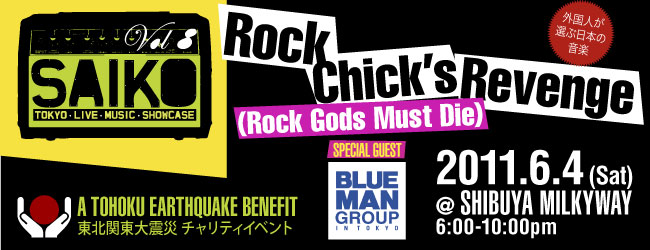

![XaverianJapan_Benefit_Flyer_Sig[1]](http://jetwit.com/wordpress/wp-content/uploads/2011/03/XaverianJapan_Benefit_Flyer_Sig1.jpg)


